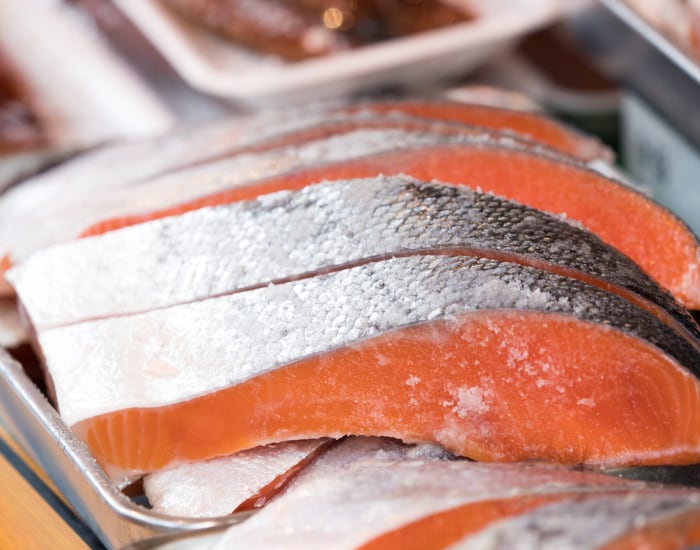6-PPD is a chemical widely used to protect car tires from ozone. However, when rainwater washes it into freshwater, 6PPD degrades into 6-PPD quinone, a contaminant that a recent study has linked to the mass deaths of Coho salmon in the Pacific Northwest of the US.
Researchers from Northeastern University and the University of Washington found that even small doses of 6PPDq were lethal for the salmon.
“For decades salmon have been dying off in vast numbers in the Pacific Northwest,” explained Eurofins Technical Director of Specialty Testing Andrew Patterson, reflecting on the study. “It is very rare to find one compound is responsible for acute toxicity.”
Shortly after the 6PPDq research was released, lab testing provider Eurofins, alongside SCIEX, began working on testing and detection methodologies to identify contamination. Patterson reached out to SCIEX to build an analytical method that leverages accurate mass spectrometry. This provides confidence the compound detected is 6PPDq, even at trace levels.
“It is critical that robust and accurate methods are created to monitor for 6PPD-quinone in our environment,” Dr Robert Di Lorenzo, Staff Scientist at SCIEX, told us.
A global problem?
To date, Dr Di Lorenzo explained, the full scale of 6PPDq contamination is not clearly understood. Most research has taken place in the Pacific Northwest where the culturally and economically important salmon stocks have been hard hit.
According to the California Water Board, Coho populations today are probably less than 6% of what they were in the 1940s, and there has been 'at least' a 70% decline since the 1960s. "There is every reason to believe that California Coho populations, including hatchery stocks, will continue to decline," the board said.
“Coho salmon are now an endangered species, and any additional stress on these species like the one caused by 6PPD-quinone needs to be taken seriously. In 2019 alone, 27 million pounds of Coho salmon were harvested, making it an important food resource. Coho are also an important cultural touchstone in the Pacific Northwest, bringing social significance to bear on this problem,” Dr Lorenzo explained.
While we know most about the impact 6PPDq contamination has on freshwater environments in the Pacific Northwest, with some 3.1 billion tires produced worldwide, chances are this could well be a global problem.
“6-PPD is a ubiquitous tire additive, so its presence in freshwater ecosystems globally is highly probable. However, currently, the most studied regions are in the Pacific Northwest, primarily Washington. Presently we only know about the toxicity to Coho salmon, so the most vulnerable areas would be waterways utilized by this species and exposed to roadway runoff. As we continue to learn about this compound and its impact on the environment, this might change.”
Patterson also believes that this should be viewed as a global problem - and one that is likely to persist for decades to come. "6PPD is added to all modern tires to achieve safety standards. Even if a replacement for 6PPD is discovered tomorrow, this will be an ongoing, global problem considering the sheer number of tires on vehicles and stacked up in tire 'graveyards'."
What does this mean for food production and human health?
While 6PPDq’s toxicity to Coho salmon is now well established, the mechanism for toxicity is not yet fully known and there is no clear understanding of the broader impact contamination could have on the water table, food production or human health.
"The degree to which 6PPD-quinone travels in the environment is not yet understood. I am aware that there are multiple studies underway to examine the kinetics and expand toxicological understanding. It is far too early to speculate on food production or impact to drinking water," Patterson told FoodNavigator.
“At this point, we don’t know much about the fate and transport of 6PPD-quinone. Researchers are looking at this currently, but it will take some time before we have answers,” Dr Di Lorenzo agreed.
“At the moment, we have no idea what, if any, impact 6PPD-quinone has on human health.”
To find an answer to this question, researchers will need access to the contamination data Eurofins is compiling, Patterson noted.
"I am not a toxicologist, but I have much respect for that field. Our role is to figure out how to extract and quantitate compounds with certainty. We supply that data to engineers and toxicologists so they can create accurate models of the concentrations we observe."
The special testing expert is ‘interested’ in seeing whether water is the only area that 6PPDq has contaminated, noting the potential for airborne contamination as well.
Noting that beehives are often located near to highways as well as orchards, Patterson revealed he collected three random samples of honey from around the region. “The good news for the bees… and humans is all three samples were non-detect,” he revealed.
“We do not have a food method yet but if we had to we could bring this up very quickly.”
'No known alternatives' to 6PPD
Dr Di Lorenzo said the issue is one that is firmly on the agenda of tire producers. “Tire producers are very aware of the seriousness of the issue at hand. 6PPD, the parent of 6PPD-quinone, is used by all USTMA members in manufacturing tires and has been in production since the 1970s. To address the concerns raised by 6PPD-quinone, the global tire industry has formed a joint task force representing USTMA, the European Tyre and Rubber Manufacturers’ Association (ETRMA), and the World Business Council for Sustainable Development’s Tire Industry Project (TIP). Additionally, they have stated that they will continue to work with the researchers studying the impacts of this compound on the environment.”
Regulators like California’s Department of Toxic Substances Control (DTSC) are also actively working with industry and researchers to address the issue.
Patterson said that to support that work, regulators require the types of data sets that companies like Eurofins are working to supply. "There are many data gaps in both occurrence and fate of 6PPD-quinone. Regulators can’t make informed decisions until these gaps are narrowed or closed."
Responding to the University of Washington study, ETRMA said in a statement: "The tyre industry uses 6PPD because it helps tyres resist degradation and cracking, which is vital for passenger safety. The tyre industry .. remains strongly committed to a continued dialogue with stakeholders, including the scientific community. We are confident that the continuous cooperation with suppliers, regulators, academia, customers and other stakeholders, is essential to advance the collective understanding and achieve the objective of a safe and sustainable mobility."
However, Dr Di Lorenzo stressed that finding a solution to the problem is complex. “6PPD is used as an antioxidant to prevent the degradation of tires, so if solving this problem means removing 6-PPD (and potentially related antioxidants) from tire rubber formulations, suitable chemical alternatives will need to be identified. Unfortunately, at the moment, there are no known alternatives to 6PPD available that are as effective.”
Source
'A ubiquitous tire rubber–derived chemical induces acute mortality in coho salmon'
Science
DOI: 10.1126/science.abd6951
Authors: Zhenyu Tian, Haoqi Zhao, Katherine T. Peter, Melissa Gonzalez, Jill Wetze, Christopher Wu, imin Hu, Jasmine Prat, Emma Mudrock, Rachel Hettinger, Allan E. Cortina, Rajshree Ghosh Biswas, Flávio Vinicius Crizóstomo Kock, Ronald Soong, Amy Jenne, Bowen Du, Fan Hou, Huan He, Rachel Lundeen, Alicia Gilbreath, Rebecca Sutton, Nathaniel L. Scholz, Jay W. Davis, Michael C. Dodd, Andre Simpson, Jenifer K. McIntyre, Edward P. Kolodziej




